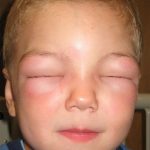 A vascular reaction usually causing swelling in the skin and/ or upper-respiratory and gastrointestinal tracts.
A vascular reaction usually causing swelling in the skin and/ or upper-respiratory and gastrointestinal tracts.
Angioedema (hereditary) is a genetic disorder associated with the deficiency of Cl inhibitor, a protein in the blood. This disorder is characterized by episodes of swelling in areas of the skin and the tissue beneath or in mucous membranes that line the openings of the body, such as the mouth, throat, genitalia, or gastrointestinal tract. Hands, feet, face, and lips may also be affected.
Sudden, well-defined, large area of edema often due to an allergy to foods or drugs.
An allergic reaction in the skin and underlying tissue marked by swelling and red blotches. Angioedema is characterized by large welts below the surface of the skin, especially around the eyes and lips, and less frequently on the hands and feet and in the throat. It is caused by the release into the bloodstream of histamine and other chemicals related to the immune system.
A condition marked by the development of edematous areas of skin, mucous membranes, or internal organs. It is frequently associated with urticaria (hives). It is benign when limited to the skin but can cause respiratory distress when present in the mouth, pharynx, or larynx. It is usually the result of a type I hypersensitivity reaction. Histamine released during an immunoglobin E antibody reaction to ingested allergens such as food or drugs causes vasodilation and increased vascular permeability, producing the characteristic nonpitting, nondependent swelling that distinguishes it from regular edema. The nonallergic forms of angioedema are hereditary angioedema, which is caused by a complement deficiency, and anaphylactoid reactions.
An intense, noninflammatory swelling of the skin, organs, and brain, potentially accompanied by fever and muscle discomfort.
Angioedema, a type of allergic reaction, shares similarities with urticaria (hives) and is distinguished by the rapid appearance of distinct, sizable swellings on the skin, larynx (voice-box), and other regions. If left unattended, these swellings can persist for several days.
The primary cause of angioedema, occurring most frequently, is a sudden allergic response triggered by the consumption of certain foods. Alternatively, although less commonly, the condition can be attributed to an allergic reaction to medications like penicillin, insect bites or stings, infections, emotional stress, exposure to animals, molds, pollens, or cold temperatures. Additionally, there exists a hereditary form of angioedema.
Angioedema can result in abrupt respiratory distress, impaired swallowing, and speech difficulties, along with swelling of the lips, face, and neck, contingent upon the specific body region affected.
When angioedema affects the throat and larynx, it poses a potentially life-threatening situation as the swelling has the potential to obstruct the airway, leading to asphyxia and suffocation.
In severe instances, the treatment approach for angioedema involves administering adrenaline (epinephrine) through injections, and in some cases, intubation (the insertion of a breathing tube through the mouth into the windpipe) or tracheostomy (a surgical procedure to create an opening in the windpipe) may be necessary to prevent suffocation. Corticosteroid medications may also be prescribed. For milder cases, symptom relief can often be achieved through the use of antihistamine drugs.
